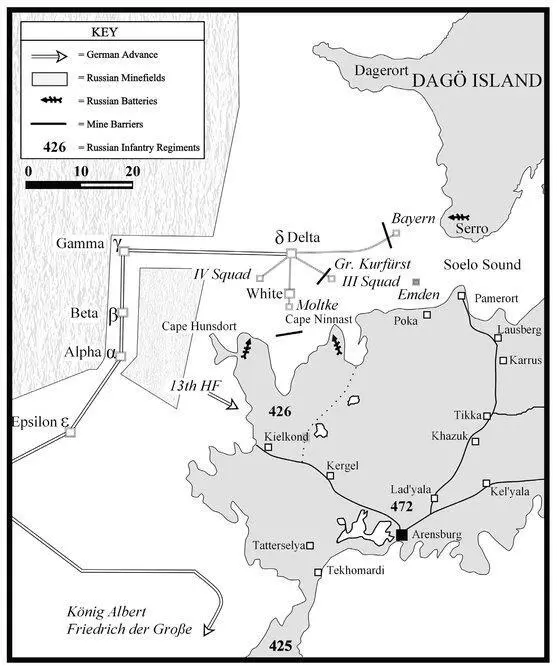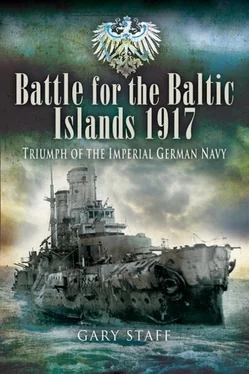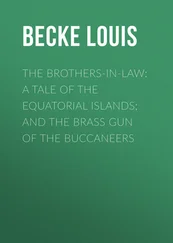The third and forth sections of the Special Unit advanced according to schedule. At about 1934hrs the main body passed point S and steered towards Epsilon. At around 2100hrs the 1st Division of the IV Battle Squadron detached to take up their allotted bombardment positions off the Sworbe Peninsula. Towards midnight SMS König arrived at point Gamma but then had to reduce speed as the II Minesweeper Flotilla now lay close ahead. The entire German formation was now beginning to bunch up. If the element of surprise was not to be lost, the pioneers needed to be at the anchorage by 0300hrs at the latest, but this was quickly becoming an impossibility. The Chief of the Special Unit was now faced with a difficult decision – either renounce the minesweeping, or else lose the effect of surprise. Without hesitation, Vizeadmiral Schmidt determined to forgo further minesweeping and gave the order to the minesweepers: ‘Immediately give room for the Fleet. Take on gear’.
Ahead of III Battle Squadron were the countless stern lanterns of the minesweeper Units and due to those and the dense clouds of funnel smoke it was difficult to discern the lights of the navigation marks. Nevertheless, because of Vizeadmiral Schmidt’s courageous decision to forgo further minesweeping, the battleships were able to anchor at their allotted positions at 0300hrs. By 0340hrs the pioneers aboard the battleships of the III Battle Squadron had disembarked and were on their way towards Tagga Bay. Ahead of them were the torpedoboats of the II Torpedoboat Flotilla and the steamers Blitz , Equity and Corsica , which were carrying the main body of the pioneers. Moltke followed this unit as support. After disembarking their troops the battleships steamed towards their bombardment positions. The three ships of IV Battle Squadron, under the command of Kommodore Meurer, would take battery No 45 at Cape Hundsort under fire, whilst the III Battle Squadron would fire on Battery No 46 at Ninnast. To cover the nearby landing at Pamerort, SMS Bayern would bombard Battery No 34 at Cape Toffri and Emden would fire on the supposed battery at Pamerort. All the ships were to remain within areas swept for mines by the S-Flotilla. However, due to a navigational error, the light vessel at point Delta was displaced 3 nautical miles from its intended position, and as the S-Flotilla had used the light vessel as a navigational fix, this meant that the areas swept for the intended bombardment positions were likewise displaced. It later transpired that all the battleships were actually operating in unswept waters during their bombardments. Therefore, it was only due to providence that there were no serious losses during the landing.

Map 2: The Approach Route of the Special Unit.
Meanwhile, the progress of the motor launches laden with pioneers was beginning to fall behind schedule, with the result that the chief of the II Torpedoboat Flotilla ordered the torpedoboats to advance and the steamers and launches to follow as quickly as possible. Moltke followed just 1,500 metres behind the last steamer, Corsica . Suddenly at 0535hrs Corsica ran onto a mine. The detonation was to starboard aft, beneath the engine room, which quickly filled with water. Moltke came forward and two of her torpedoboat escorts were sent to Corsica to take off the troops, the II Battalion, 138 Regt. This was carried out expeditiously and without loss. Corsica was towed to Cape Merris and beached, where repairs were carried out before she returned to Libau. Evidently there was a small Russian mine barrier running eastwards across the entrance to Tagga Bay and this was subsequently swept by the II Minesweeper Flotilla.
Just prior to this, at about 0520hrs, the sound of cannon thunder was heard to port. It could only be coming from Bayern , despite the fact that fire was only to be opened on receipt of orders from the flagship. The pioneers had already pushed forward into Tagga Bay and were poised to land. Vizeadmiral Schmidt, therefore, gave the order ‘open fire’ at 0527hrs. At 0544hrs the ships of the IV Battle Squadron, Kaiser , Prinzregent Luitpold and Kaiserin , opened fire on the guns at Hundsort, which were clearly visible. At the same time the Russian battery replied with a salvo, which, however, was aimed at Moltke . The Russian firing was accurate, the first salvo fell just 100 metres short of Moltke , the second was over and the third was 50 metres off the bow. Moltke joined in the firing and she and the IV Battle Squadron continued for some time: by 0617hrs the battleships lay just 8 kilometres from Hundsort. The command and communication post at Cape Hundsort was taken under bombardment but all twenty-five men of the 5th Company of the 426th Povenets Regiment remained resolutely at their posts. The firing continued while the landing took place but by 0745hrs the IV Battle Squadron had anchored.
Meanwhile, the III Battle Squadron, under Vizeadmiral Behncke, took up their positions to bombard Battery No 46 at Ninnast. At 0440hrs Bayern had been detached for her task of silencing Battery No 34 at Toffri. When the order to open fire arrived at 0527hrs, the III Battle Squadron were still unable to make out their allotted target and initially mistook Cape Pank for Cape Ninnast. It was only at 0545hrs that the Russian battery was sighted and taken under fire with the medium calibre guns at a range of 4,600 metres. Vizeadmiral Behncke had decided to conserve the barrels of his heavy artillery. The Russian battery did not reply so that after nine minutes fire was ceased, only to be reopened shortly after 0600hrs when lively activity around the battery was observed. With that the Russian gunners finally abandoned their battery and towards 0752hrs the III Battle Squadron dropped anchor to conserve coal.
Earlier, whilst still en route to their bombardment position, the battleship Grosser Kurfürst had run onto a mine at about 0509hrs. The mine struck to starboard forward and the wing passage, protective and outer bunkers all filled with water, although a total of only 280 tonnes entered the ship. Grosser Kurfürst ’s draught increased by a third of a metre but she held her place in line and completed the bombardment. Later in the afternoon she, together with the other ships of the III Battle Squadron, was detached to Putzig Wiek, and from there to Wilhelmshaven, which she reached on October 18th. She was repaired in the Imperial Dockyard and was returned to the Fleet on 1 December.
The landing at Pamerort and the eventual breakthrough into the Soelo Sound were under the direction of the I FdT, Kommodore Heinrich, aboard the cruiser SMS Emden . The battleship Bayern , mounting eight 38cm guns, was to silence Battery Toffri and support the landing, and, as mentioned previously, had detached from the III Battle Squadron at 0440hrs. A short time later, at 0507hrs, a detonation occurred to port forward and a grey-black water column of comparatively small diameter was thrown up 8 to 10 metres. A watch-engineer aboard Bayern , Oberleutnant (I) der Reserve Lorenz, described the situation which followed:
The siren of the engine telegraph howled as the three black indicators hastily jumped into the red part of the scale: ‘Utmost power astern – stop!’ The ship sank perceptibly deeper by the bow to a new trim position. On the bridge they had seen a grey-black water and smoke column…. Announced by shrill whistles, many speaking tubes delivered their reports: ‘Bow torpedo room and forward torpedo broadside room full of water, approximately 1,000 tonnes of water in the ship, the leak is secure!’ Quietly and orderly, just as in battle practice, further reports and confirmations arrived: four large compartments were flooded, their crews, (seven men), gave no answer….
Читать дальше













